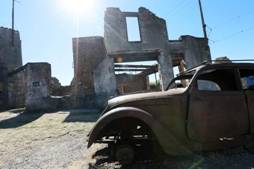Remembrance Tourism in France [fr]
Verdun, Omaha Beach, Péronne, Caen, Oradour are among the 155 remembrance sites throughout France.
Most of these destinations were recently adapted for tourism.
 80% of them were opened in 1980 with immediate success. According to a joint survey by Atout France, the French Tourism Development Agency, and the French Defence Ministry, almost 6.2 million people visited these sites in 2012, including 45% of foreigners. 70% of foreign visitors come from five countries, as follows: the United Kingdom (17%), Germany (16.5%), Belgium (15.5%), the Netherlands (13.2%) and the United States (8.1%). A significant part of visitors who are keenly interested in history come from the four following French regions: the “Grand Est” (Big East) region accounts for 24% of them, the Ile-de-France region for 18%, and the “Nord” (North) region for 15%.
80% of them were opened in 1980 with immediate success. According to a joint survey by Atout France, the French Tourism Development Agency, and the French Defence Ministry, almost 6.2 million people visited these sites in 2012, including 45% of foreigners. 70% of foreign visitors come from five countries, as follows: the United Kingdom (17%), Germany (16.5%), Belgium (15.5%), the Netherlands (13.2%) and the United States (8.1%). A significant part of visitors who are keenly interested in history come from the four following French regions: the “Grand Est” (Big East) region accounts for 24% of them, the Ile-de-France region for 18%, and the “Nord” (North) region for 15%.
A major increase in tourist numbers is expected in 2014 owing to the start of celebrations marking the Centenary of the First World War and the 70th anniversary of the D-Day Normandy Landings. Visitors are also expected in great numbers during the next two years for the centenary of several First World War battles that are emblematic for countries of The Commonwealth, including the Battle of the Somme, the most deadly of the entire War with a majority of British and German casualties.
Australians and New Zealanders, who particularly like to visit places steeped in memory to pay tribute to the heroism of their forebears, are also expected in great numbers on Anzac Day on 25 April 2015 in Villers-Bretonneux in the Somme where almost 60,000 lost their lives in the trenches. Canadians, for their part, are planning to visit France on 4 April 2017 to celebrate the Battle of Vimy Ridge in the Nord-Pas-de-Calais region, which took a particularly high toll on their soldiers.
It was estimated in a number of UK newspapers that these numerous commemorations were likely to prompt three million more visitors from the United Kingdom and its former Dominions (South Africa, Australia, Canada and New Zealand) to visit France by 2018. The influx of tourists to the regions concerned is expected to generate big revenues and significantly boost the tourism industry.
“Visitors in remembrance can be divided into four categories,” says the Managing Director of Atout France. According to him, there are "the battle sites and ’witness to war’ sites, like Omaha Beach, the martyred village of Oradour-sur-Glane, and the Chemin des Dames.
 Commemorative sites, on the other hand, are places of remembrance and memory such as the Necropolis of Notre-Dame-de-Lorette in the Nord-Pas-de-Calais region, the Douaumont Ossuary in Verdun and the Hartmannswillerkopf Memorial in Alsace.” There are also sites that provide information, where history is presented from a specific standpoint, like the Caen Memorial Museum and the Museum of the Great War, Pays de Meaux. Pedagogical sites like the World Peace Centre in Verdun emphasize the will to draw the lessons of the past.
Commemorative sites, on the other hand, are places of remembrance and memory such as the Necropolis of Notre-Dame-de-Lorette in the Nord-Pas-de-Calais region, the Douaumont Ossuary in Verdun and the Hartmannswillerkopf Memorial in Alsace.” There are also sites that provide information, where history is presented from a specific standpoint, like the Caen Memorial Museum and the Museum of the Great War, Pays de Meaux. Pedagogical sites like the World Peace Centre in Verdun emphasize the will to draw the lessons of the past.
The rapid development of remembrance tourism has led the French government to release significant financial resources in collaboration with local governments, with a view to restoring existing sites and museums. By 2018, the French Ministry for Veterans and Remembrance will thus spend an additional €40 million to renovate military cemeteries and the tombs of soldiers who fell for France.
NB: The claims and opinions contained in this article, aimed at providing information on contemporary France, have no official value.